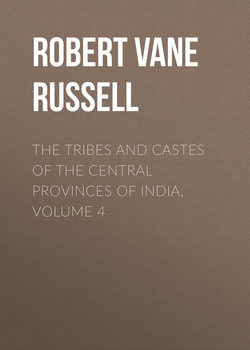Читать книгу The Tribes and Castes of the Central Provinces of India, Volume 4 - Robert Vane Russell - Страница 123
Part II
Articles on Castes and Tribes
Kumhār—Yemkala
Vol. IV
Mahār
15. Occupation
ОглавлениеThe principal occupations of the Mahārs are the weaving of coarse country cloth and general labour. They formerly spun their own yarn, and their fabrics were preferred by the cultivators for their durability. But practically all thread is now bought from the mills; and the weaving industry is also in a depressed condition. Many Mahārs have now taken to working in the mills, and earn better wages than they could at home. In Bombay a number of them are employed as police-constables.136 They are usually the village watchmen of the Marātha Districts, and in this capacity were remunerated by contributions of grain from the tenants, the hides and flesh of animals dying in the village, and plots of rent-free land. For these have now been substituted in the Central Provinces a cash payment fixed by Government. In Berār the corresponding official is known as the Kāmdār Mahār. Mr. Kitts writes of him:137 As fourth balutedār on the village establishment the Mahār holds a post of great importance to himself and convenience to the village. To the patel (headman), patwāri and big men of the village, he acts often as a personal servant and errand-runner; for a smaller cultivator he will also at times carry a torch or act as escort. He had formerly to clean the horses of travellers, and was also obliged, if required, to carry their baggage.138 For the services which he thus renders as pāndhewār the Mahār receives from the cultivators certain grain-dues. When the cut juāri is lying in the field the Mahārs go round and beg for a measure of the ears (bhīk payāli). But the regular payment is made when the grain has been threshed. Another duty performed by the Mahār is the removal of the carcases of dead animals. The flesh is eaten and the skin retained as wage for the work. The patel and his relatives, however, usually claim to have the skins of their own animals returned; and in some places where half the agriculturists of the village claim kinship with the patel, the Mahārs feel and resent the loss. A third duty is the opening of grain-pits, the noxious gas from which sometimes produces asphyxia. For this the Mahārs receive the tainted grain. They also get the clothes from a corpse which is laid on the pyre, and the pieces of the burnt wood which remain when the body has been consumed. Recent observations in the Nāgpur country show that the position of the Mahārs is improving. In Nāgpur it is stated:139 “Looked down upon as outcastes by the Hindus they are hampered by no sense of dignity or family prejudice. They are fond of drink, but are also hard workers. They turn their hands to anything and everything, but the great majority are agricultural labourers. At present the rural Mahār is in the background. If there is only one well in the village he may not use it, but has to get his water where he can. His sons are consigned to a corner in the village school, and the schoolmaster, if not superior to caste prejudices, discourages their attendance. Nevertheless, Mahārs will not remain for years downtrodden in this fashion, and are already pushing themselves up from this state of degradation. In some places they have combined to dig wells, and in Nāgpur have opened a school for members of their own community. Occasionally a Mahār is the most prosperous man in the village. Several of them are moneylenders in a small way, and a few are mālguzārs.” Similarly in Bhandāra Mr. Napier writes that a new class of small creditors has arisen from the Mahār caste. These people have given up drinking, and lead an abstemious life, wishing to raise themselves in social estimation. Twenty or more village kotwārs were found to be carrying on moneylending transactions on a small scale, and in addition many of the Mahārs in towns were exceedingly well off.
136
Bombay Gazetteer, vol. xi p. 73.
137
Bombay Gazetteer, vol. xi. p. 73.
138
Grant Duff; History of the Marāthas, vol. i. p. 24.
139
Nāgpur Settlement Report (1899), p. 29.
